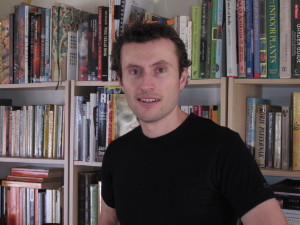
Brian Martin is an independent writer and researcher. He is an athletics coach, fitness instructor and running tragic. Brian has worked as a business systems analyst, actor, playwright and within the University sector as an online learning specialist.

Help me promote this book. If you enjoyed this book and would like to promote it on your website, you can do this and make a commission. The publisher of this book Smashwords has an affiliate program that generates a commission each time someone clicks on your link and buys the book. For more information visit http://www.smashwords.com/about/affiliate.
My next running books. Planned for writing are a beginner runner guide and a specific book about running in minimalist shoes. Keep an eye out for these at my www.smashwords.com author page.
For my latest musings, visit my blog: http://www.runningtechniquetips.com
Visit my coaching practice at: http://www.runningtechniquecoach.com
I tweet sparingly at: @TechniqueTips
Running Technique Tips is also on Facebook.
****
Carrier, D. R. & Kapoor, A. K. & Kimura, T. & Nickels, M. K. & Satwanti & Scott, E. C. & So, J. K. & Trinkaus, E. (1984). The Energetic Paradox of Human Running and Hominid Evolution. Current Anthropology, 25(4), 483-495.
Lieberman, D. E. & Bramble, D.M. (2007) The Evolution of Marathon Running: Capabilities in Humans. Sports Med, 37(4-5), 288-290.
Lieberman, D.E. Venkadesan, M. Werbel, W.A. Daoud, A.I. Andrea, S.D. Davis, I.S. Ojiambo, R. Mang’Eni & Pitsiladis, Y. (2010) Foot strike patterns and collision forces in habitually barefoot versus shod runners. Nature, Vol 463
Kolb, D. (1984) Experiential Learning: experience as the source of learning and development. Englewood Cliffs, New Jersey: Prentice Hall.
Mann, R. A. & Moran, G. T. & Dougherty, S. E. (1986). Comparative electromyography of the lower extremity in jogging, running and sprinting. American Journal of Sports Medicine, 14(6), 501-510.
Leskinen, A. & Hakkinen, K. & Virmavirta, M. & Isolehto, J. & Kyrolainen, H. (2009). Comparison of running kinematics between elite and national-standard 1500-m runners. Sports Biomechanics, 8(1), 1-9.
Mann, R. A. & Hagy, J. (1980). Biomechanics of walking running and sprinting. American Journal of Sports Medicine, 8(5), 345-350.
Bushnell, T. & Hunter, I. (2007). Differences in technique between sprinters and distance runners at equal and maximal speeds. Sports Biomechanics, 6(3), 261-268.
Novacheck, T. F. (1998). Review Paper: The biomechanics of running. Gait and Posture, 7, 77-95.
Dugan, S. A. & Bhat, K. P. (2005). Biomechanics and Analysis of Running Gait. Physical Medicine and Rehabilitation Clinics of North America, 16, 603-621.
Saunders, P. U. & Pyne, D. B. & Telford, R. D. & Hawley, J. A. (2004). Factors Affecting Running Economy in Trained Distance Runners. Sports Med, 34(7), 465-485.
Smoliga, J. M. & Myers, J. B. & Redfern, M. S. & Lephart, S. M. (2010). Reliability and precision of EMG in leg, torso and arm muscles during running. Journal of Electromyography, 20, e1-e9.
Karp, J. R. ( ). Strength Training and Distance Running: A Scientific Perspective. Modern Athlete & Coach.
Bartlett, R. & Wheat J. & Robins, M. (2007). Is movement variability important for sports biomechanists? Sports Biomechanics, 6(2), 224-243.
Folland, J. P. & Williams, A. G. (2007). The Adaptations to Strength Training: Morphological and Neurological Contributions to Increased Strength. Sports Med 37(2), 145-168.
Saunders, P. U. (). Plyometric Training: with emphasis on improving running economy for distance runners. Modern Athlete & Coach.
Paavolainen, L. & Hakkinen, K. & Hamalainen, I. & Nummela, A. & Rusko, H. (1999). Explosive-strength training improves 5-km running time by improving running economy and muscle power. The American Physiological Society, 99, 8750-7587.
Berryman, N. & Maurel, D. & Bosquet, L. (2010). Effect of Plyometric vs. Dynamic Weight Training on the Energy Cost of Running. Journal of Strength and Conditioning Research, 0,(0)1-7.
Birch, B. B. (2004). Asana: Virabhadrasana III, Warrior Pose III. Yoga Journal, March/April, 118-129.
Reiman, M. P. & Bolgla, L. A. & Lorenz, D. (2009). Hip Function’s Influence on Knee Dysfunction: A Proximal Link to a Distal Problem. Journal of Sport Rehabilitation, 18, 33-46.
Paluska, S. A. (2005). An Overview of Hip Injuries in Running. Sports Med, 35(11), 991-1014.
Hesar, N. G. Z. & Ginckel, A. V. & Cools, A. (2009). A prospective study on gait-related intrinsic risk factors for lower leg overuse injuries. British Journal of Sports Medicine, 43, 1057-1061.
Kawamoto, R. & Ishige, Y. & Watarai, K. & Fukashiro, S. (2002). Primary Factors Affecting Maximum Torsional Loading of the Tibia in Running. Sports Biomechanics (1)2, 167-186.
Niemuth, R. E. (2007). The role of hip muscle weakness in lower extremity athletic injuries. International SportMed Journal, 8(4) 179-192.
Wilk, B. R. & Nau, S. & DeLeon, A. (2007) The Nike Free as a Useful Tool for Video Gait Analysis. AMAA Journal, Fall, 17.
Richards, C. E. & Magin, P. J. & Callister, R. (2010). Is your prescription of distance running shoes evidence-based? British Journal of Sports Medicine, 43, 159-162.
Ryan, M. B. & Valiant, G. A. & McDonald, K. (2010), The effect of three different levels of footwear stability on pain outcomes in women runners: a randomized control trial. British Journal of Sports Medicine, online 10.1136/bjsm.2009.069849.
Knapik, J. J., et al (2010) Injury Reduction Effectiveness of Assigning Running shoes based on Plantar Shape in Marine Corps Basic Training. American Journal of Sports Medicine.
Stefanyshyn, D. & Fusco, C. (2004). Increased Shoe Bending Stiffness Increases Sprint Performance. Sports Biomechanics, 3(1), 55-66.
Butcher. P. (2010) Late Convert Josphat Menjo. Globerunner.org.
Books
Daniels, J. T. (2005). Daniels’ Running Formula, Second Edition. Human Kinetics.
Connors, S. & Murphy, S. (2008). Running Well: Run smarter, run faster, avoid injury! Human Kinetics.
Delavier, F. (2001). Strength Training Anatomy: Your illustrated guide to muscles at work. Human Kinetics.
Cash, M. (2000), Pocket Atlas of the Moving Body. Ebury Press. Random House.
Bosch, F. & Klomp, R. (2005) Running: Biomechanics and Exercise Physiology Applied in Practice. Elsevier, Churchill, Livingstone.
Pfitzinger, P. & Douglas, S. (2009) Advanced Marathoning, Second Edition. Human Kinetics.
####